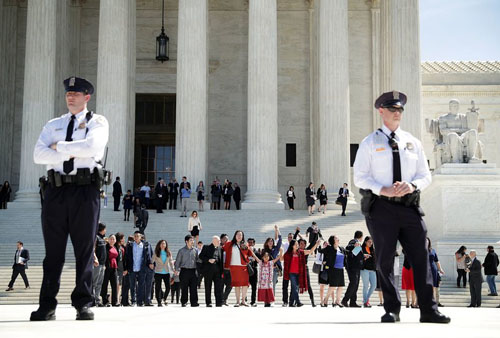美国的移民法院体系深陷麻烦亟需改革

|
自从特朗普2016年当选以来,他对美国移民体系的改革力度可谓史无前例。美国的移民审查执行办公室(EOIR)差不多已经成了一台移民遣返机器。而且美国移民执法力度的增长速度已经超过了EOIR自身的增长速度,造成了大量案件积压。而给移民法官下达“办案指标”,只会继续加剧这一乱象。 据说美国移民法院体系中现有70万件积压案件,人人都能看出美国的移民法院体系出现了危机。新的“办案指标”制度要求法官平均每天至少要审理三件移民案件,也就是说,每名面临遣返的移民只有不到两个小时的时间为自己辩护。在这么短的时间内,法官是否能够仔细审查证据,给出公平公正的裁决,恐怕要画一个大大的问号。 很多移民案件的裁决,说关乎人的生死,也不为过。对于这些人,他们拥有举行一次充分公平公正的听证会的权利,但这样的听证会在两个小时里能开完吗?可是每超时一分钟,法官离被摘帽子就近了一步,在这样的压力下,他的裁决难道不会受到影响吗? 去年1月,特朗普放弃了之前在移民执法领域较为明智的做法。他将移民执法的目标从犯罪分子和危害国家安全人员转移到了几乎所有人身上。去年,美国移民部门逮捕的非罪犯移民增长了一倍以上。我估计,今年有更多与美国有深度联系的人已经上了被驱逐的名单,而他们本来有充分的理由留在美国,而且就算走正常法院流程,也不会被驱逐得如此之快。 2017年春季和夏季,美国开始大张旗鼓在美墨边境遣返移民,全国各地的法官都不得不暂时抛开手头的工作,被抽调去搞这个“遣返专项行动”,这也使积压的案件进一步膨胀。好几位法官都表示对此无能为力。2017年,美国移民部门在美墨边境抓人的力度降下来了,来自墨西哥的净移民数量近几于零。从去年夏天开始,美国司法部门开始反对法院的大多数行政撤案或终止审理的决定,即便是对遭受虐待的儿童和遭受家庭暴力者等社会弱势群体也毫不手软。这些人目前正在试图通过EOIR以外的机构以合法渠道留在美国。但是除非法官不顾政府的反对结案,否则他们的案件还将积压在法院的案卷柜里。 对于法官不顾司法官员反对而选择撤案或延长审理期的做法,美国司法部长杰夫·赛辛斯提到了今年年初遇到的两起撤案的案件,公开质疑法官是否有权力单方面结案,或是给予未结案的移民继续居留的许可,从而让他们可以继续申领移民福利。 但这些改变都没有缓解案件积压的现状。 简单说来,移民执法力度的快速增长,已经超过了法庭的审理极限,而且法官也被剥夺了独立的审理权。与此同时,政府却要把能抓到的每个移民都拉去遣返。政府的律师也要求法官,对于有可能或是应该撤案的案件,不要表现出一丝仁慈。 法院必须给予每个人一次公平公正的听证权利。新的“办案指标”只会带来更多诉讼,让本已不堪重负的移民法官背上更大的压力。同时它也完全忽视了执法部门在缓解移民诉讼案件积压上的关键作用。当然,EOIR也可以采取一些措施提高工作效率,确保将该走的程序都走到,比如采用能快速追踪的电子档案系统,继续保留行政结案等明智措施以便对诉讼案件进行总量控制等,同时也要保障相关人的法律代理权。最后,以上针对移民法院的强力措施也提醒了我们,EOIR毕竟是司法部下面的行政机构,而不是一个独立的司法机关。国会应当建立一套独立的移民法院体系。这样的独立司法体系,税法已经有了,破产法也有了,难道移民的问题不是更重要吗?(财富中文网) 注:本文作者Jeremy McKinney是一名律师和移民法专家。 译者:朴成奎 |
Since Donald Trump became president in 2016, the Trump Administration has engaged in what seems to be an unprecedented effort to transform our immigration court system—the Executive Office for Immigration Review (EOIR)—into little more than a deportation machine. The expansion of immigration enforcement has outpaced the growth of EOIR, creating a bottleneck, and the new quotas for immigration judges will just exacerbate the mess. With a backlog approaching 700,000 cases, everyone agrees our immigration courts are in crisis. But these quotas will force judges to complete an average of three cases per day, affording less than two hours for individuals facing deportation to present their case and for the judge to consider the evidence and render an informed, deliberate decision. Many cases are complex matters of life-and-death. For these people, how can the right to a full and fair hearing be accomplished in this time? And if the judges do slow down to carefully consider a complex issue, how will that decision be impacted when a judge knows every extra minute could put them closer to being fired? In January of last year, the president rescinded ongoing efforts at smarter immigration enforcement. He diverted enforcement efforts from criminals and national security targets to simply anyone, and immigration arrests of non-criminals more than doubled last year. I predict that more people with deep ties to the United States are now in deportation proceedings—people with viable cases to remain here who cannot be moved as quickly through the courts. During the spring and summer of 2017, judges around the nation were unnecessarily pulled out of their courtrooms for temporary assignments along the U.S.-Mexican border, further swelling court dockets. Several judges reported having little to do, border arrests were down in 2017, and net migration from Mexico has steadily been at or near zero. Then, starting last summer, government attorneys began opposing most motions to administratively close or terminate proceedings, even for the most vulnerable members of our society, like abused children and victims of domestic violence, who are pursuing legal avenues to remain in the United States through agencies other than EOIR. Now, their cases remain on the court docket unless the judge closes the case over government opposition. In response to judges closing or continuing cases over the opposition from government attorneys, Attorney General Jeff Sessions referred two removal cases to himself earlier this year, openly questioning whether judges even have the power to unilaterally close cases or grant continuances for people with pending applications for immigration benefits. None of these changes are reducing the backlog. Simply put, the rapid growth and reach of immigration enforcement has outpaced the finite resources of the court system, and judges are being stripped of independence at the same time that the administration is putting anyone it can get its hands on into deportation proceedings, and government lawyers have been commanded to no longer be merciful in cases that can and should be closed. The court’s focus must be on each individual’s right to a full and fair hearing. The new quotas will only create more litigation and further pressure beleaguered immigration judges, while completely ignoring the key role that the enforcement arm has in alleviating swollen dockets. EOIR can take steps improving efficiency and guaranteeing due process, such as fast-tracking an electronic filing system, preserving smart docket control practices like administrative closure, and promoting the right to legal representation. Ultimately, these strong-arm tactics used against the immigration courts is a reminder that EOIR is an arm of the Department of Justice rather than part of the judicial branch. Congress must establish an independent immigration court system. We have one for tax law. We have one for bankruptcy. Aren’t the stakes higher here? Jeremy McKinney is an attorney and NC board-certified specialist in immigration law. |













